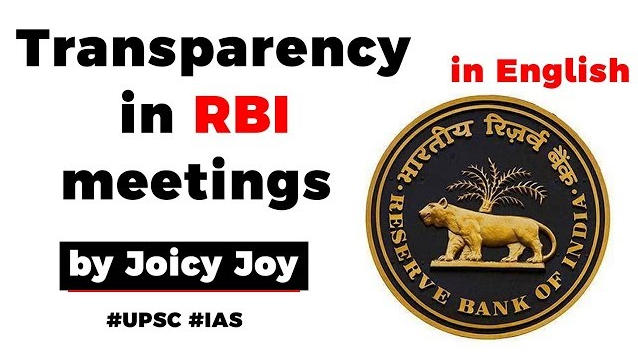Table of Contents
CURRENT AFFAIR
- Recently, the Reserve Bank of India (RBI) has released the minutes of the 579th meeting of Central Board of Directors for the first time as part of the central bank’s transparency initiative.
Key Points
- The disclosure of the information is considered as a measure to enhance public awareness about the functioning of the RBI.
- The minutes of the meetings of the Central Board will be uploaded on the RBI’s website under provisions of Section 4 of the Right to Information (RTI) Act.
Section 4 of the Right to Information (RTI) Act
- Section 4 of the RTI Act requires suo motu disclosure of information by each public authority.
CURRENT PRACTICE
- So far, the regulator only shared the minutes of board meetings in response to queries under the RTI Act.
FUTURE
- In future, the minutes will be placed on the RBI website within two weeks from the date of its confirmation in the next meeting of the Central Board and on being signed by the chairman in the same
Central Board of RBI
- RBI’s business is overseen by Central Board of
- It is categorised into official and non official directors.
- It delegates the functions to its committees and sub-
- Centraal Board of Directors holds minimum 6 meetings every year.
- Out of which, at least 1 meeting every quarter is held.
Composition of RBI’s Central Board of Directors
- It comprises RBI Governor, Deputy Governors, four non-official Directors which are nominated by Central
- 10 Non-official Directors nominated by RBI itself (These are persons having expertise in various segments of Indian Economy).
- Besides, there is one representative (usually Financial Services Secretary) of Central Government nominated under Section 8 (1) (d) of the RBI Act.
General mandate of the Board
- It generally meets in Delhi at least once when the Finance Minister addresses the full Board after presenting the Budget for the coming year.
- S/he outlines the government’s economic philosophy behind the policy initiatives proposed.
- Besides Delhi and Mumbai, the Board generally meets in various state capitals.
- The Governor seeks advice of the Board, but finally it is his decision.
Key functions of the Board
- The Committee of the Central Board meets every week and basically reviews the statistics in RBI’s weekly
- Two key sub-committees that are chaired by the Governor are
- Board for Financial Supervision (BFS)
- Board for Payment and Settlement Systems (BPSS)
- There are other sub-committees on information technology, building, audit and risk management, and HR management.
BFS
- The BFS meets every month and includes deputy governors as ex-officio members and four other
- It undertakes supervision of banks, financial institutions and NBFCs (Non Banking Financial Company).
BPSS
- The BPSS takes care of paper-based and electronic systems such as NEFT (National Electronic Funds Transfer) and RTGS (Real-time gross settlement).
The Monetary Policy Committee (MPC)
- Monetary policy refers to the policy of the Reserve Bank of India with regard to the use of monetary instruments under its control to achieve the goals of GDP growth and lower inflation rate.
- The RBI is authorized to made monetary policy under the Reserve Bank of India Act, 1934.
- Monetary policy refers to the credit control measures adopted by the Central Bank of a country.
- The Monetary Policy Committee (MPC) constituted by the Central Government under Section 45ZB.
- The MPC determines the policy interest rate required to achieve the inflation target.
- The Reserve Bank’s Monetary Policy Department (MPD) assists the Monetary Policy Committee (MPC) in forming the monetary policy.
- The Monetary Policy Committee determines the policy rates required to achieve the inflation target.
Latest Burning Issues | Free PDF






















 WhatsApp
WhatsApp